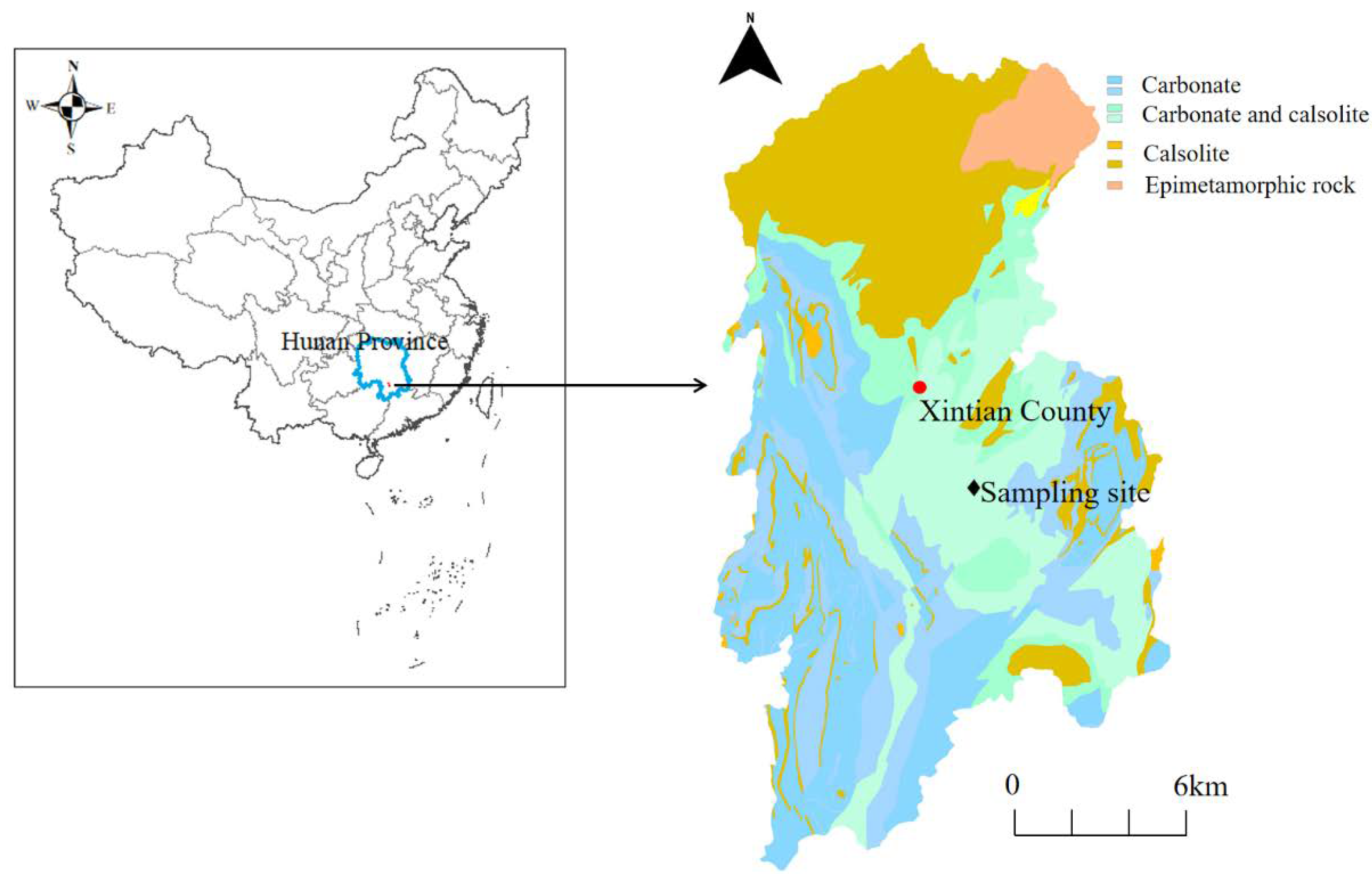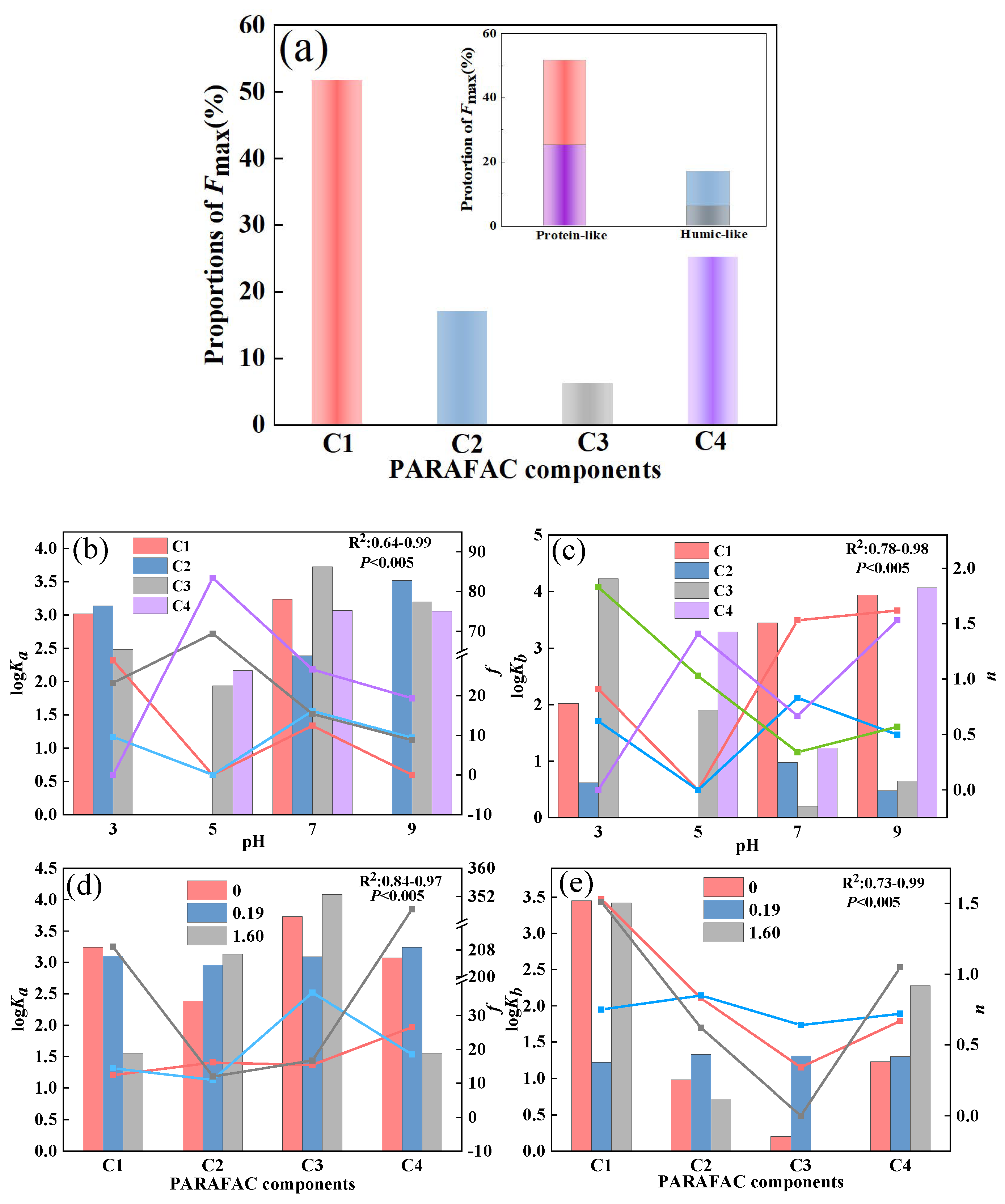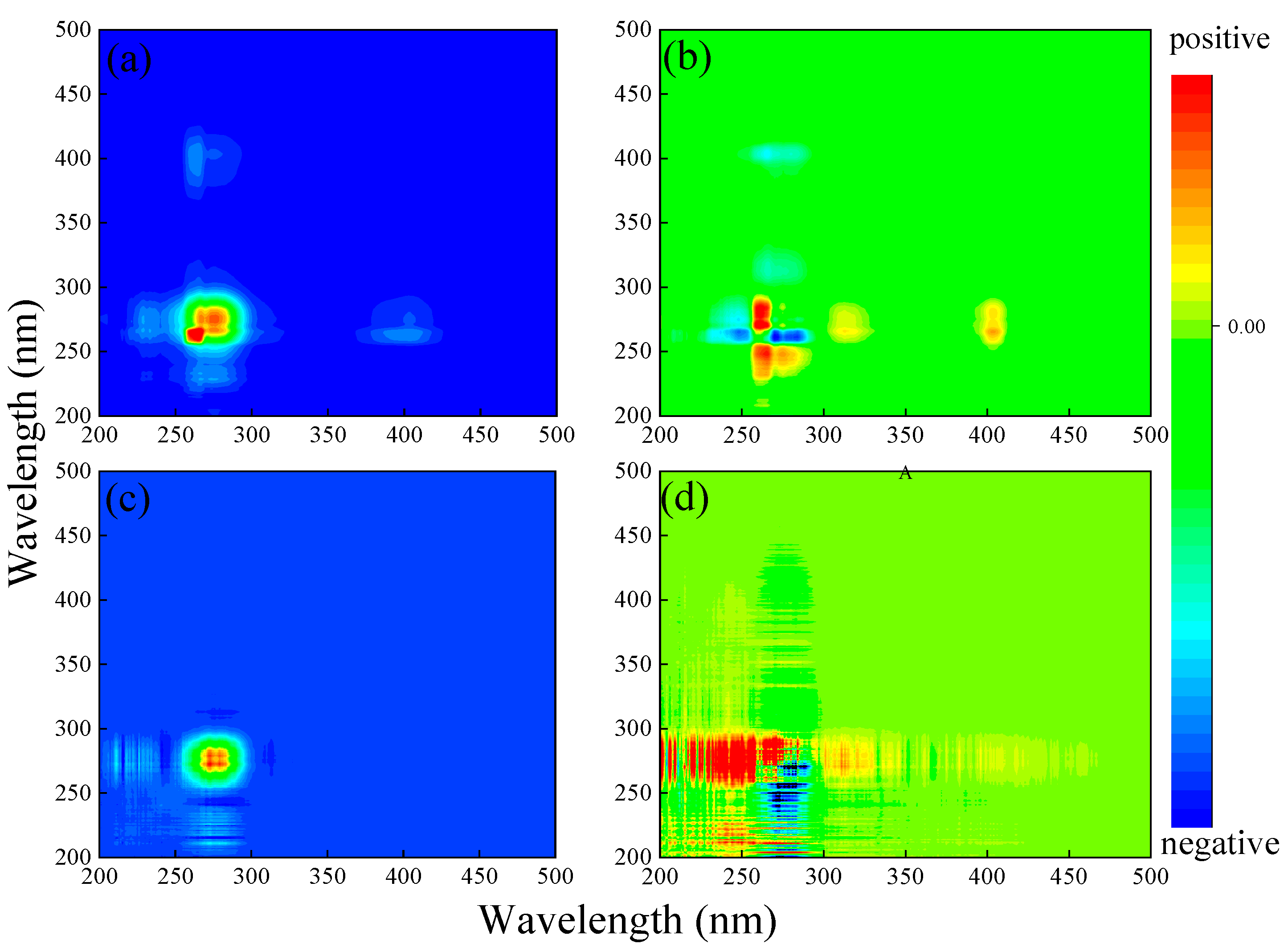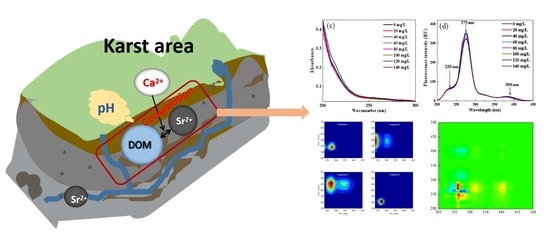Investigating the Binding Properties between Strontium and Dissolved Organic Matter under the Influence of pH and Ca2+ in a Typical Karst Area, China
Abstract
:1. Introduction
2. Materials and Methods
2.1. Study Area and DOM Preparation
2.2. Fluorescence Quenching Titration
2.2.1. DOM Interaction with Sr2+ and pH Condition Setting
2.2.2. Effect of Ca2+ on the Interaction between DOM and Sr2+
2.3. Fluorescence and Absorbance Measurement
2.4. Data Analysis
2.4.1. Two-Dimensional COS Analysis
2.4.2. PARAFAC Modeling
2.4.3. Complexation Modeling
2.5. Nomenclature
3. Results and Discussion
3.1. Characteristics of DOM Extracted from Soil
3.1.1. UV-Vis Analysis
3.1.2. EEM-PARAFAC Analysis
3.2. DOM–Sr Binding Behavior
3.2.1. UV-Vis and SF Spectra
3.2.2. Two-Dimensional COS of SF Spectra
3.2.3. Sr-Binding Abilities of PARAFAC Components
3.3. Influence of pH Conditions on the Interaction between DOM Extracted from Soil and Sr2+
3.4. Effect of Ca2+ on the Interaction between DOM Extracted from Soil and Sr2+
3.4.1. Interaction of Ca2+ with DOM Extracted from Soil
3.4.2. The Interaction between DOM Extracted from Soil and Sr in the Presence of Ca
4. Conclusions
Supplementary Materials
Author Contributions
Funding
Institutional Review Board Statement
Informed Consent Statement
Data Availability Statement
Conflicts of Interest
References
- Yuan, D.X.; Zhang, C. Karst dynamics theory in China and its Practice. Acta Geosci. Sin. 2008, 29, 355–365. (In Chinese) [Google Scholar]
- Jiang, Y.; Cao, M.; Yuan, D.; Zhang, Y.; He, Q. Hydrogeological characterization and environmental effects of the deteriorating urban karst groundwater in a karst trough valley: Nanshan, SW China. Hydrogeol. J. 2018, 26, 1487–1497. [Google Scholar] [CrossRef]
- Lv, W.; Yao, X.; Su, C.; Ren, H.; Yao, M.; Zhang, B. Characteristics and influencing factors of hydrochemistry and dissolved organic matter in typical karst water system. Environ. Sci. Pollut. Res. 2020, 27, 11174–11183. [Google Scholar]
- Stefan, K.; Gerhard, K.; Miran, V. Decision support systems for groundwater protection: Innovative tools for resource management. Environ. Geol. 2006, 49, 840–848. [Google Scholar]
- Banner, J.L. Radiogenic isotopes: Systematics and applications to earth surface processes and chemical stratigraphy. Earth-Sci. Rev. 2004, 65, 141–191. [Google Scholar] [CrossRef]
- Musgrove, M.L. The occurrence and distribution of strontium in U.S. groundwater. Appl. Geochem. 2021, 126, 104867. [Google Scholar] [CrossRef]
- Nielsen, S.P. The biological role of strontium. Bone 2004, 35, 583–588. [Google Scholar] [CrossRef]
- Su, C.T.; Huang, C.H.; Zou, S.Z.; Xie, D.X.; Zhao, G.S.; Tang, J.S.; Luo, F.; Yang, Y. Enrich environment and sources of strontium of groundwater in Xintian county, Hunan Province. Carsologica Sin. 2017, 36, 678–683. (In Chinese) [Google Scholar]
- Yamaguchi, N.; Nakamura, T.; Dong, D.; Takahashi, Y.; Amachi, S.; Makino, T. Arsenic release from flooded paddy soils is influenced by speciation, Eh, pH, and iron dissolution. Chemosphere 2011, 83, 925–932. [Google Scholar] [CrossRef] [PubMed]
- An, J.; Jho, E.H.; Nam, K. Effect of dissolved humic acid on the Pb bioavailability in soil solution and its consequence on ecological risk. J. Hazard. Mater. 2015, 286, 236–241. [Google Scholar] [CrossRef]
- Zhang, H.F.; Zheng, Y.C.; Wang, X.C.; Wang, Y.K.; Dzakpasu, M. Characterization and biogeochemical implications of dissolved organic matter in aquatic environments. J. Environ. Manag. 2021, 294, 113041. [Google Scholar] [CrossRef] [PubMed]
- Haney, R.L.; Haney, E.B.; Smith, D.R.; Harmel, R.D.; White, M.J. The soil health tool—Theory and initial broad-scale application. Appl. Soil Ecol. 2018, 125, 162–168. [Google Scholar] [CrossRef]
- Araujo, E.; Strawn, D.G.; Morra, M.; Moore, A.; Alleoni, L.R.F. Association between extracted copper and dissolved organic matter in dairy-manure amended soils. Environ. Pollut. 2019, 246, 1020–1026. [Google Scholar] [CrossRef] [PubMed]
- Polubesova, T.; Chefetz, B. DOM-affected transformation of contaminants on mineral surfaces: A review. Crit. Rev. Environ. Sci. Technol. 2014, 44, 223–254. [Google Scholar] [CrossRef]
- Borggaard, O.K.; Holm, P.E.; Strobel, B.W. Potential of dissolved organic matter (DOM) to extract As, Cd, Co, Cr, Cu, Ni, Pb, and Zn from polluted soils: A review. Geoderma 2019, 343, 235–246. [Google Scholar] [CrossRef]
- Hu, X.P.; Qu, C.C.; Han, Y.F.; Chen, W.L.; Huang, Q.Y. Elevated temperature altered the binding sequence of Cd with DOM in arable soils. Chemosphere 2022, 288, 132572. [Google Scholar] [CrossRef]
- Fan, Y.R.; Zheng, C.L.; Huo, A.D.; Wang, Q.R.; Shen, Z.X.; Xue, Z.W.; He, C. Investigating the binding properties between antimony(V) and dissolved organic matter (DOM) under different pH conditions during the soil sorption process using fluorescence and FTIR spectroscopy. Ecotoxicol. Environ. Saf. 2019, 181, 34–42. [Google Scholar] [CrossRef]
- Brigante, M.; Zanini, G.; Avena, M. On the dissolution kinetics of humic acid particles effects of pH, temperature and Ca2+ concentration. Colloids Surf. A Physicochem. Eng. Asp. 2007, 294, 64–70. [Google Scholar] [CrossRef]
- Chen, W.B.; Smith, D.S.; Gueguen, C. Influence of water chemistry and dissolved organic matter (DOM) molecular size on copper and mercury binding determined by multiresponse fluorescence quenching. Chemosphere 2013, 92, 351–359. [Google Scholar] [CrossRef]
- Habibul, N.; Chen, W. Structural response of humic acid upon binding with lead: A spectroscopic insight. Sci. Total Environ. 2018, 643, 479–485. [Google Scholar] [CrossRef]
- Lu, Y.F.; Allen, H.E. Characterization of copper complexation with natural dissolved organic matter (DOM)—Link to acidic moieties of DOM and competition by Ca and Mg. Water Res. 2002, 36, 5083–5101. [Google Scholar] [CrossRef]
- Xu, H.C.; Yan, Z.S.; Cai, H.Y.; Yu, G.H.; Yang, L.Y.; Jiang, H.L. Heterogeneity in metal binding by individual fluorescent components in a eutrophic algae-rich lake. Ecotoxicol. Environ. Saf. 2013, 98, 266–272. [Google Scholar] [CrossRef] [PubMed]
- Poulin, B.A.; Ryan, J.N.; Aiken, G.R. Effects of iron on optical properties of dissolved organic matter. Environ. Sci. Technol. 2014, 48, 10098–10106. [Google Scholar] [CrossRef]
- Liu, M.X.; Han, X.K.; Liu, C.Q.; Guo, L.D.; Ding, H.; Lang, Y.C. Differences in the spectroscopic characteristics of wetland dissolved organic matter binding with Fe3+, Cu2+, Cd2+, Cr3+ and Zn2+. Sci. Total Environ. 2021, 800, 149476. [Google Scholar] [CrossRef]
- Ren, H.Y.; Fan, T.T.; Yao, X.; Ma, F.Y.; Liu, L.; Ming, J.D.; Wang, S.T.; Zhang, Y.H.; Deng, H.G. Investigation of the variations in dissolved organic matter properties and complexations with two typical heavy metals under the influence of biodegradation: A survey of an entire lake. Sci. Total Environ. 2022, 806, 150485. [Google Scholar] [CrossRef]
- Fan, T.T.; Yao, X.; Ren, H.Y.; Ma, F.Y.; Liu, L.; Huo, X.J.; Lin, T.; Zhu, H.Y.; Zhang, Y.H. Multispectroscopic investigation of the molecular weight distribution and copper binding ability of dissolved organic matter in Dongping Lake, China. Environ. Pollut. 2022, 300, 118931. [Google Scholar] [CrossRef]
- Su, C.T.; Yang, Y.; Ba, J.J.; Luo, F.; Li, X.P.; Zhao, G.S. Dynamic characteristics and genesis of strontium-rich groundwater in Xintian county, Hunan Province. Carsologica Sin. 2020, 39, 24–33. (In Chinese) [Google Scholar]
- Murphy, K.R.; Stedmon, C.A.; Graeber, D.; Bro, R. Fluorescence spectroscopy and multiway techniques. PARAFAC. Anal. Methods 2013, 5, 6557–6566. [Google Scholar] [CrossRef] [Green Version]
- Yamashita, Y.; Jaffe, R. Characterizing the interactions between trace metals and dissolved organic matter using excitation-emission matrix and parallel factor analysis. Environ. Sci. Technol. 2008, 42, 7374–7379. [Google Scholar] [CrossRef]
- Wang, D.; Peng, Q.; Yang, W.X.; Dinh, Q.T.; Tran, T.A.; Zhao, X.D.; Wu, J.T.; Liu, Y.X.; Liang, D.L. DOM derivations determine the distribution and bioavailability of DOM-Se in selenate applied soil and mechanisms. Environ. Pollut. 2020, 259, 113899. [Google Scholar] [CrossRef]
- Yan, L.L.; Liu, Q.P.; Liu, C.; Liu, Y.; Zhang, M.Y.; Zhang, Y.D.; Zhang, Y.; Gu, W.R. Effect of swine biogas slurry application on soil dissolved organic matter (DOM) content and fluorescence characteristics. Ecotoxicol. Environ. Saf. 2019, 184, 109616. [Google Scholar] [CrossRef] [PubMed]
- Cui, H.Y.; Zhao, Y.; Chen, Y.N.; Wang, X.Q.; Qian, L.; Jia, L.M.; Wei, Z.M. Assessment of phytotoxicity grade during composting based on EEM/PARAFAC combined with projection pursuit regression. J. Hazard. Mater. 2017, 326, 10–17. [Google Scholar] [CrossRef] [PubMed]
- Lu, F.; Chang, C.H.; Lee, D.J.; He, P.J.; Shao, L.M.; Su, A. Dissolved organic matter with multipeak fluorophores in landfill leachate. Chemosphere 2009, 74, 575–582. [Google Scholar] [CrossRef]
- Kowalczuk, P.; Durako, M.J.; Young, H.; Kahn, A.E.; Copper, W.J.; Gonsior, M. Characterization of dissolved organic matter fluorescence in the South Atlantic Bight with use of PARAFAC model: Interannual variability. Mar. Chem. 2009, 113, 182–196. [Google Scholar] [CrossRef]
- Kleber, M. What is recalcitrant soil organic matter? Environ. Chem. 2010, 7, 320. [Google Scholar] [CrossRef]
- McFarland, J.W.; Ruess, R.W.; Kielland, K.; Pregitzer, K.; Hendrick, R. Glycine mineralization in situ closely correlates with soil carbon availability across six North American forest ecosystems. Biogeochemistry 2010, 99, 175–191. [Google Scholar] [CrossRef]
- Liu, H.; Yang, W.; Ai, Z.; Zhang, J.; Zhang, C.; Xue, S.; Liu, G. Effects of the interaction between temperature and revegetation on the microbial degradation of soil dissolved organic matter (DOM)—A DOM incubation experiment. Geoderma 2019, 337, 812–824. [Google Scholar] [CrossRef]
- Liu, W.; Zhang, L.; Liu, P.; Qin, X.; Shan, X.; Yao, X. FDOM conversion in Karst watersheds expressed by three-dimensional fluorescence spectroscopy. Water 2018, 10, 1427. [Google Scholar] [CrossRef] [Green Version]
- Noda, I. Techniques useful in two-dimensional correlation and codistribution spectroscopy (2DCOS and 2DCDS) analyses. J. Mol. Struct. 2016, 1124, 29–41. [Google Scholar] [CrossRef]
- Chauhan, R.; Kumar, R.; Kumar, V.; Sharma, K.; Sharma, V. On the discrimination of soil samples by derivative diffuse reflectance UV-vis-NIR spectroscopy and chemometric methods. Forensic Sci. Int. 2020, 319, 110655. [Google Scholar] [CrossRef]
- Baker, A. Thermal fluorescence quenching properties of dissolved organic matter. Water Res. 2005, 39, 4405–4412. [Google Scholar] [CrossRef] [PubMed]
- Wang, Z.G.; Cao, J.; Meng, F.G. Interactions between protein-like and humic-like components in dissolved organic matter revealed by fluorescence quenching. Water Res. 2015, 68, 404–413. [Google Scholar] [CrossRef] [PubMed]
- Lin, D.H.; Tian, X.L.; Li, T.T.; Zhang, Z.Y.; He, X.; Xing, B.S. Surface-bound humic acid increased Pb2+ sorption on carbon nanotubes. Environ. Pollut. 2012, 167, 138–147. [Google Scholar] [CrossRef] [PubMed]
- Lanne, R.W.P.M. Influence of pH on the fluorescence of dissolved organic matter. Mar. Chem. 1982, 11, 395–401. [Google Scholar] [CrossRef]
- Yan, M.Q.; Fu, Q.W.; Li, D.C.; Gao, G.F.; Wang, D.S. Study of the pH influence on the optical properties of dissolved organic matter using fluorescence excitation-emission matrix and parallel factor analysis. J. Lumin. 2013, 142, 103–109. [Google Scholar] [CrossRef]
- Chen, W.; Westerhoff, P.; Leenheer, J.A.; Booksh, K. Fluorescence excitation-emission matrix regional integration to quantify spectra for dissolved organic matter. Environ. Sci. Technol. 2003, 37, 5701–5710. [Google Scholar] [CrossRef]
- Dryer, D.J.; Korshin, G.V.; Fabbricino, M. In situ examination of the protonation behavior of fulvic acids using differential absorbance spectroscopy. Environ. Sci. Technol. 2008, 42, 6644–6649. [Google Scholar] [CrossRef]
- Patel-Sorrentino, N.; Mounier, S.; Benaim, J.Y. Excitation-emission fluorescence matrix to study pH influence on organic matter fluorescence in the Amazon basin rivers. Water Res. 2002, 36, 2571–2581. [Google Scholar] [CrossRef]
- Yin, K.Y.; Wang, J.Y.; Zhai, S.; Xu, X.; Li, T.T.; Sun, S.C.; Xu, S.; Zhang, X.X.; Wang, C.P.; Hao, Y.S. Adsorption mechanisms for cadmium from aqueous solutions by oxidant-modified biochar derived from Platanus orientalis Linn leaves. J. Hazard. Mater. 2022, 428, 128261. [Google Scholar] [CrossRef]
- Meng, J.; Feng, X.L.; Dai, Z.M.; Liu, X.M.; Wu, J.J.; Xu, J.M. Adsorption characteristics of Cu(II) from aqueous solution onto biochar derived from swine manure. Environ. Sci. Pollut. Res. 2014, 21, 7035–7046. [Google Scholar] [CrossRef]
- Boonamnuayvitaya, V.; Chaiya, C.; Tanthapanichakoon, W.; Jarudilokkul, S. Removal of heavy metals by adsorbent prepared from pyrolyzed coffee residues and clay. Sep. Purif. Technol. 2004, 35, 11–22. [Google Scholar] [CrossRef]
- Batool, S.; Idrees, M.; Hussain, Q.; Kong, J. Adsorption of copper (II) by using derived-farmyard and poultry manure biochars: Effificiency and mechanism. Chem. Phys. Lett. 2017, 689, 190–198. [Google Scholar] [CrossRef]
- Cao, Y.; Conklin, M.; Betterton, E. Competitive complexation of trace-metals with dissolved humic-acid. Environ. Health Perspect. 1995, 103, 29–32. [Google Scholar]
- Aggarwal, V.; Hui, L.; Boyd, S.; Teppen, B. Enhanced sorption of trichloroethene by smectite clay exchanged with Cs2+. Environ. Sci. Technol. 2006, 40, 894–899. [Google Scholar] [CrossRef] [PubMed]
- Cheng, C.; Wang, J.; Yang, X.; Li, A.; Philippe, C. Adsorption of Ni(II) and Cd(II) from water by novel chelating sponge and the effect of alkali-earth metal ions on the adsorption. J. Hazard. Mater. 2014, 264, 332–341. [Google Scholar] [CrossRef]







| DOM+Sr2+ Components | Modified Stern-Volmer Equation | Site-Binding Equation | ||||||
|---|---|---|---|---|---|---|---|---|
| logKa | f | R2 | p | logKb | n | R2 | p | |
| C1 | 3.24 | 12.4 | 0.92 | <0.005 | 3.45 | 1.53 | 0.89 | <0.005 |
| C2 | 2.39 | 16.1 | 0.99 | <0.005 | 0.98 | 0.83 | 0.97 | <0.005 |
| C3 | 3.73 | 15.4 | 0.74 | <0.005 | 0.20 | 0.34 | 0.89 | <0.005 |
| C4 | 3.07 | 26.6 | 0.98 | <0.005 | 1.23 | 0.67 | 0.98 | <0.005 |
| DOM+Ca2+ | ||||||||
| C1 | - | - | - | - | - | - | - | - |
| C2 | 2.95 | 17.1 | 0.95 | <0.005 | 0.92 | 0.66 | 0.95 | <0.005 |
| C3 | 2.34 | 24.4 | 0.77 | <0.005 | 5.37 | 2.26 | 0.93 | <0.005 |
| C4 | 2.88 | 13.9 | 0.77 | <0.005 | 1.82 | 0.98 | 0.87 | <0.005 |
Publisher’s Note: MDPI stays neutral with regard to jurisdictional claims in published maps and institutional affiliations. |
© 2022 by the authors. Licensee MDPI, Basel, Switzerland. This article is an open access article distributed under the terms and conditions of the Creative Commons Attribution (CC BY) license (https://creativecommons.org/licenses/by/4.0/).
Share and Cite
Yao, X.; Su, C.; Fan, T.; Ren, H.; Luo, F. Investigating the Binding Properties between Strontium and Dissolved Organic Matter under the Influence of pH and Ca2+ in a Typical Karst Area, China. Land 2022, 11, 1376. https://doi.org/10.3390/land11091376
Yao X, Su C, Fan T, Ren H, Luo F. Investigating the Binding Properties between Strontium and Dissolved Organic Matter under the Influence of pH and Ca2+ in a Typical Karst Area, China. Land. 2022; 11(9):1376. https://doi.org/10.3390/land11091376
Chicago/Turabian StyleYao, Xin, Chuntian Su, Tuantuan Fan, Haoyu Ren, and Fei Luo. 2022. "Investigating the Binding Properties between Strontium and Dissolved Organic Matter under the Influence of pH and Ca2+ in a Typical Karst Area, China" Land 11, no. 9: 1376. https://doi.org/10.3390/land11091376
APA StyleYao, X., Su, C., Fan, T., Ren, H., & Luo, F. (2022). Investigating the Binding Properties between Strontium and Dissolved Organic Matter under the Influence of pH and Ca2+ in a Typical Karst Area, China. Land, 11(9), 1376. https://doi.org/10.3390/land11091376







